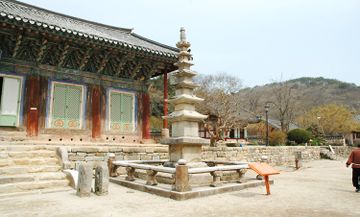"고창 선운사 육층석탑"의 두 판 사이의 차이
(→영문) |
(→영문) |
||
| 39번째 줄: | 39번째 줄: | ||
===영문=== | ===영문=== | ||
| − | '''Six-story Stone Pagoda of | + | '''Six-story Stone Pagoda of Seonunsa Temple, Gochang''' |
A pagoda is a symbolic monument enshrining the relics or remains of the Buddha. Although not all pagodas contain the true remains, they are nonetheless worshiped as sacred places that enshrine the Buddha. | A pagoda is a symbolic monument enshrining the relics or remains of the Buddha. Although not all pagodas contain the true remains, they are nonetheless worshiped as sacred places that enshrine the Buddha. | ||
| − | This stone pagoda is presumed to | + | This stone pagoda located in front of Daeungbojeon Hall of Seonunsa Temple, Gochang, is presumed to date to the Goryeo period (918-1392). It is thought to have originally had nine stories, based on historical records and on the unbalanced proportions seen in parts of the pagoda. |
| − | + | The pagoda measures 6.2 m in height and consists of a platform, a base, six sets of body and roof stones, and a decorative top. '''The square base features an octagonal pedestal and a square capstone ''with decorative engravings along the edge. The corners are carved to resemble pillars''.''' The height of the body stones abruptly decreases between the first and second stories, while the width of the roof stones suddenly narrows between the second and third stories. The roof stones feature a slight upward curve, while the decorative top features an unusual octagonal flower ornament. The pagoda is enclosed by a stone balustrade. | |
| + | |||
| + | *밭침돌에 대한 설명이 잘못되어 있습니다. (국문도 문제입니다.) 바침돌은 하단, 중단, 상단부로 이루지는데 하단 부분만 팔각형입니다. 사진을 보니 우주항 안상무늬 등이 있어서 그 내용을 추가했습니다. (너무 긴 것 같으면 우주 문장 등 이탤릭체로 표기한 내용을 빼도 될 것 같아요.) | ||
| + | *행호선사 이야기를 뺐어요. 증거자료의 역할로 언급되는데 그냥 '기록에 의하면'이라고 하면 될 것 같아요. | ||
| + | *비례가 안 맞는 것에 대한 이야기는 9층석탑인 것으로 알 수 있는 증거인 것 같아서 그 내용을 두번째 문단에서 언급했어요. | ||
===영문 해설 내용=== | ===영문 해설 내용=== | ||
2023년 11월 20일 (월) 11:49 판
| 선운사 육층석탑 |
|
 선운사 육층석탑, 국가문화유산포털, 문화재청. |
|
| 대표명칭 | 선운사 육층석탑 |
|---|---|
| 한자 | 禪雲寺 六層石塔 |
| 주소 | 전라북도 고창군 아산면 선운사로 250 (삼인리) |
| 지정번호 | 전라북도 유형문화재 제29호 |
| 지정일 | 1973년 6월 23일 |
| 분류 | 유적건조물/종교신앙/불교/탑 |
| 시대 | 조선시대 |
| 수량/면적 | 1기 |
| 웹사이트 | 선운사 육층석탑, 국가문화유산포털, 문화재청. |
해설문
국문
화강암으로 만든 고려시대 석탑으로, 원래는 9층이었으나 현재는 6층(높이 6.2m)만이 남아있다. 선운사의 역사를 기록한 사적기(事蹟記)에는 조선 성종 3년(1472)에 행호 선사(幸浩 禪師)가 홀로 우뚝 솟은 9층 석탑을 보고 사찰을 다시 중창(重創)했다는 내용이 있어 이후 3개 층을 잃은 것으로 보인다.
기단부는 사각형의 축대 안에 지대석*을 마련했고, 그 위로 팔각에 가까운 받침돌과 몸돌(塔身)을 올렸다.
탑신부는 사각형의 몸돌과 지붕돌(屋蓋石)을 6층으로 올렸고, 지붕돌의 처마는 양 끝에서 모두 들려 있다. 전체적으로 몸돌의 2층 높이가 급격히 줄어들고 3층 지붕돌이 2층에 비해 폭이 좁아져 비례감이 떨어진다.
탑의 맨윗부분인 상륜부에는 복발**이 있고 그 위로 팔각의 귀꽃으로 장식한 보개***를 얹어 놓았는데 일반 석탑과는 조금 다른 모습이다.
지붕돌 등에서 백제 탑 양식이 보이는 등 지방의 특색이 잘 담긴 석탑이다.
- 지대석(址臺石): 건축물이 세워지는 곳을 주위보다 조금 높이기 위해 쌓는 돌
- 복발(覆鉢): 엎어놓은 밥그릇을 모양의 장식
- 보개(寶蓋): 탑에서 바퀴 모양의 장식인 보륜(寶輪) 위에 덮개 모양의 장식
영문
Six-story Stone Pagoda of Seonunsa Temple, Gochang
A pagoda is a symbolic monument enshrining the relics or remains of the Buddha. Although not all pagodas contain the true remains, they are nonetheless worshiped as sacred places that enshrine the Buddha.
This stone pagoda located in front of Daeungbojeon Hall of Seonunsa Temple, Gochang, is presumed to date to the Goryeo period (918-1392). It is thought to have originally had nine stories, based on historical records and on the unbalanced proportions seen in parts of the pagoda.
The pagoda measures 6.2 m in height and consists of a platform, a base, six sets of body and roof stones, and a decorative top. The square base features an octagonal pedestal and a square capstone with decorative engravings along the edge. The corners are carved to resemble pillars. The height of the body stones abruptly decreases between the first and second stories, while the width of the roof stones suddenly narrows between the second and third stories. The roof stones feature a slight upward curve, while the decorative top features an unusual octagonal flower ornament. The pagoda is enclosed by a stone balustrade.
- 밭침돌에 대한 설명이 잘못되어 있습니다. (국문도 문제입니다.) 바침돌은 하단, 중단, 상단부로 이루지는데 하단 부분만 팔각형입니다. 사진을 보니 우주항 안상무늬 등이 있어서 그 내용을 추가했습니다. (너무 긴 것 같으면 우주 문장 등 이탤릭체로 표기한 내용을 빼도 될 것 같아요.)
- 행호선사 이야기를 뺐어요. 증거자료의 역할로 언급되는데 그냥 '기록에 의하면'이라고 하면 될 것 같아요.
- 비례가 안 맞는 것에 대한 이야기는 9층석탑인 것으로 알 수 있는 증거인 것 같아서 그 내용을 두번째 문단에서 언급했어요.
영문 해설 내용
불탑은 부처의 유골을 모신 상징적인 조형물이다. 모든 탑이 진신사리를 모신 것은 아니지만, 부처를 모신 신성한 곳으로 여겨 신앙의 대상이 된다.
이 석탑은 고려시대에 만들어진 것으로 추정된다. 선운사의 역사를 기록한 문헌에 1472년 승려 행호가 홀로 우뚝 서 있는 9층 석탑을 보고 선운사를 중창하였다는 내용이 있는 것으로 보아 원래는 9층 석탑으로 만들어졌던 것으로 보인다.
현재 6층 석탑의 높이는 6.2m이고, 지대석, 팔각형의 받침돌, 6층의 몸돌과 지붕돌, 머리장식으로 이루어져 있다. 2층 몸돌부터 높이가 급격히 줄어들고 3층 지붕돌부터는 폭이 좁아져 전체적으로 비례감이 떨어진다. 지붕돌은 처마 끝이 들려 있다. 머리장식에는 팔각의 꽃 모양 장식이 달려 있는데 이는 일반적인 석탑의 머리장식과는 조금 다른 모습이다. 석탑 주변에는 사각형의 난간을 둘렀다.